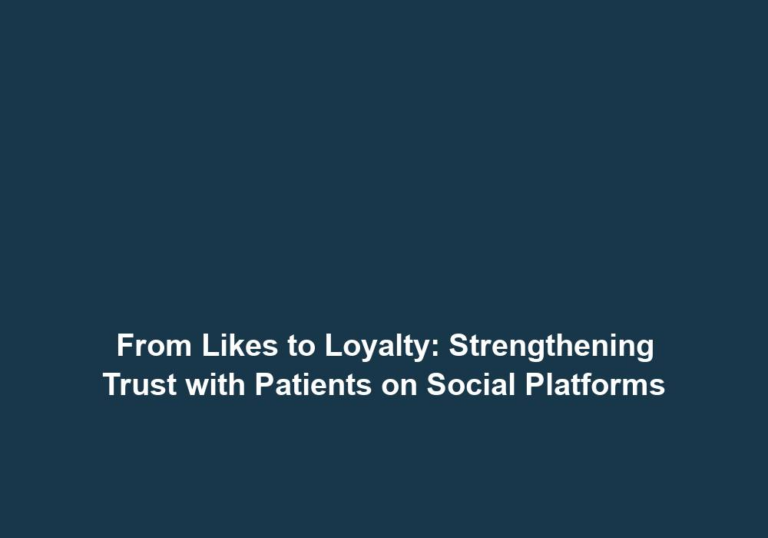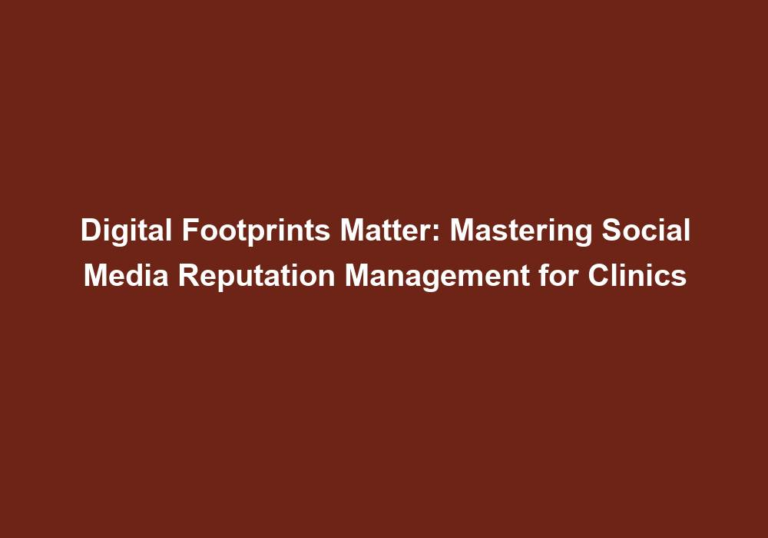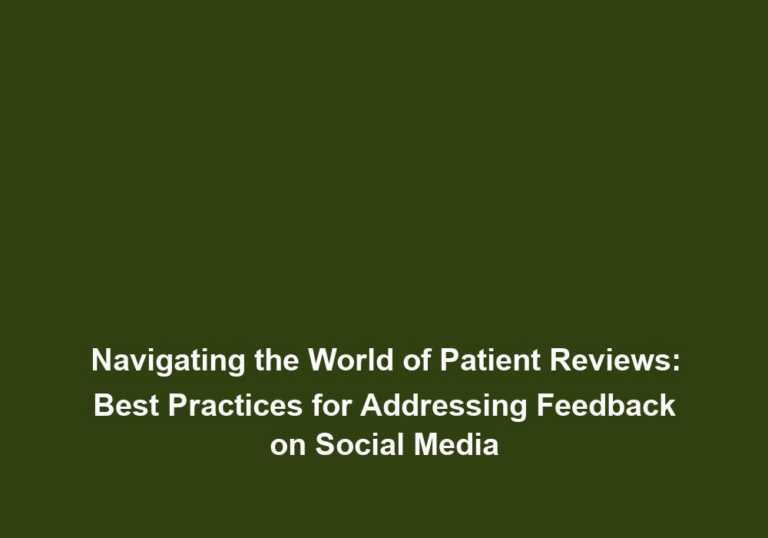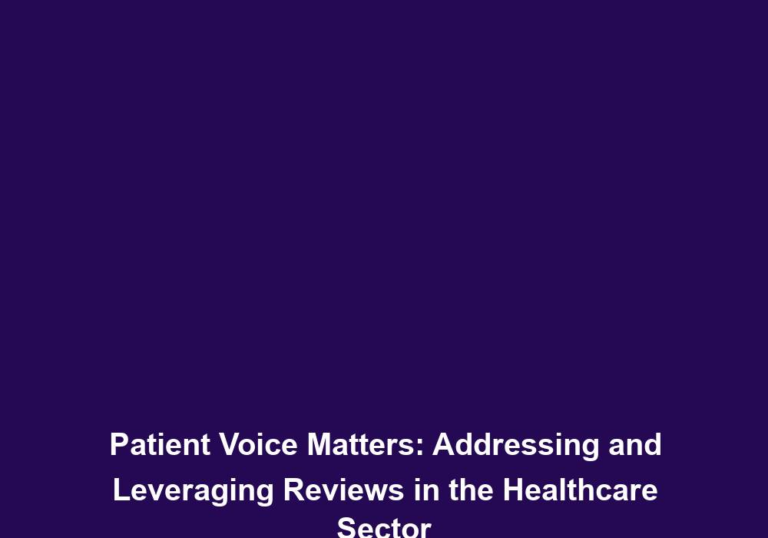From Likes to Loyalty: Strengthening Trust with Patients on Social Platforms
In the digital age, social media has become an integral part of our lives. It has revolutionized the way we communicate, connect, and share information. For healthcare providers, leveraging social platforms can be a powerful tool to build trust and strengthen relationships with their patients. From likes to loyalty, here are some valuable strategies to effectively engage with patients on social media and establish a trustworthy online presence.
The Power of Social Media in Healthcare
Social media platforms have transformed the healthcare landscape by providing a space for patients, healthcare professionals, and organizations to interact and share information. It enables healthcare providers to reach a vast audience, educate patients, raise awareness about health issues, and provide timely updates and advice. However, to truly harness the power of social media, healthcare providers need to go beyond simply accumulating likes and follows. They must focus on cultivating patient loyalty and building a strong foundation of trust.
Expanding on this topic, social media platforms offer healthcare providers the opportunity to connect with patients on a personal level. By sharing valuable and informative content, providers can educate patients about their health, promote healthy lifestyles, and empower them to make informed decisions. Additionally, social media allows healthcare providers to address common health concerns and frequently asked questions, reducing patient anxiety and promoting trust in professional help.
To further engage patients, healthcare providers should also share success stories of previous patients. These stories not only inspire and motivate others but also foster a sense of community among patients. By showcasing the positive outcomes of their services, healthcare providers can build trust and establish themselves as reliable sources of care.
Understanding Patient Expectations
To effectively engage with patients on social media, it is crucial to understand their expectations and needs. Patients seek healthcare providers who are knowledgeable, empathetic, and accessible. They want to feel heard, supported, and well-informed. By recognizing these desires, healthcare providers can tailor their social media content to meet patient expectations and create a trusted relationship.
Expanding on this topic, healthcare providers can create engaging and informative content by following these tips:
-
Educate: Healthcare providers should share insightful articles, videos, or infographics that empower patients to make informed decisions about their health. Offering tips, advice, and best practices for maintaining a healthy lifestyle helps patients feel supported and informed.
-
Answer FAQs: Addressing frequently asked questions and providing clear, concise answers helps patients feel supported and reduces anxiety about seeking professional help. By offering prompt and helpful responses, healthcare providers can establish themselves as reliable sources of information.
-
Share Success Stories: Highlighting patient success stories on social media can inspire and motivate others. Personal narratives are powerful tools in fostering trust and building a sense of community.
-
Demystify Medical Jargon: Simplifying complex medical terms and concepts ensures that patients can easily grasp the information. Clarifying misunderstandings and promoting health literacy are crucial for effective communication.
-
Promote Patient Advocacy: Encouraging patients to share their experiences and provide feedback is essential for creating a patient-centered approach. Actively engaging with patient comments, reviews, and suggestions demonstrates a commitment to patient care.
Building Trust through Transparency
Transparency is fundamental when it comes to building trust with patients on social media. Openly sharing information about your practice, values, and qualifications fosters credibility and helps patients feel more confident in their choice of healthcare provider. Here are some strategies to enhance transparency:
-
Profile and About Sections: Ensuring that social media profiles are complete and up-to-date is crucial. Including relevant information about qualifications, areas of expertise, and affiliations helps patients understand a healthcare provider’s background and builds credibility.
-
Privacy and Security: Assuring patients that their personal information is secure and protected is essential. Clearly communicating privacy policies and adhering to regulatory standards helps build trust and confidence.
-
Timely Responses: Responding promptly to patient inquiries, comments, and direct messages demonstrates a commitment to patient care and establishes a reputation for being accessible and responsive.
-
Share Behind-the-Scenes: Providing a glimpse into the practice by sharing stories, photos, or videos that showcase the team, facilities, and daily operations humanizes the practice and makes it more relatable. This helps patients feel connected and builds trust.
Engaging in Meaningful Conversations
Social media is not just a platform to disseminate information – it is also an opportunity to engage in meaningful conversations with patients. Actively participating in discussions, addressing patient concerns, and providing empathetic support can significantly contribute to building trust. Here are some ways to engage in meaningful conversations:
-
Ask Questions: Encouraging patients to share their thoughts, experiences, and concerns by asking open-ended questions fosters dialogue and demonstrates a commitment to understanding their needs.
-
Respond Empathetically: Showing empathy and compassion when responding to patient comments or messages is crucial. Acknowledging their concerns and providing thoughtful, personalized responses helps build trust and strengthen the patient-provider relationship.
-
Patient Stories & Testimonials: Sharing patient testimonials or stories (with consent) inspires others and creates a sense of community. This can help patients feel more connected and supported, ultimately strengthening trust.
-
Collaborate with Influencers: Collaborating with influential individuals or organizations in the healthcare industry widens reach and taps into established communities. This collaboration can boost credibility and attract new patients.
Leveraging Data to Improve Patient Experience
Data analysis plays a vital role in understanding patients’ preferences and needs. By analyzing social media metrics, healthcare providers can gain insights into what content resonates with their audience and make informed decisions to enhance the patient experience. Here are some ways to leverage data effectively:
-
Analyze Engagement: Tracking social media metrics such as likes, shares, comments, and click-through rates helps identify which content generates the most engagement. This understanding allows healthcare providers to focus on topics or formats that their audience finds most valuable.
-
Monitor Sentiment: Regularly monitoring patient sentiment by analyzing comments, reviews, and mentions allows healthcare providers to address any negative experiences promptly and improve patient satisfaction.
-
Adapt and Improve: Using data-driven insights to refine social media strategies and optimize content delivery is essential. By experimenting with different formats, posting times, or topics, healthcare providers can enhance patient engagement and satisfaction.
Conclusion
Building trust with patients on social media requires a strategic approach that goes beyond accumulating likes and follows. By understanding patient expectations, creating valuable content, promoting transparency, engaging in meaningful conversations, and leveraging data, healthcare providers can establish a trustworthy online presence and foster patient loyalty. Remember, from likes to loyalty, every interaction on social platforms has the potential to strengthen the bond between healthcare providers and their patients.
This article is written in markdown format for easy formatting and readability.







